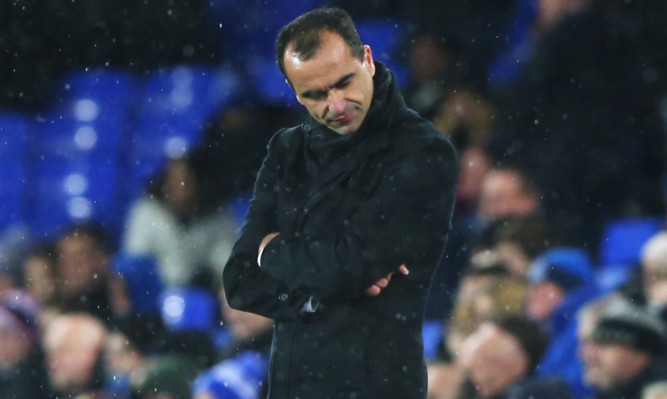
These are tough times for Roberto Martinez and he needs more from Romelu Lukaku and Samuel Eto’o.
The honeymoon is over. The pressure is mounting. The storm clouds are gathering.
You can pick your own cliche when it comes to Everton boss Roberto Martinez.
His team can’t win football matches, the fans are frustrated and for the first time since his appointment 18 months ago and doubts are being expressed about his ability.
The statistics make bleak reading. One win in 12 games in all competitions, a few points off the relegation zone, out of the FA Cup.
The Spaniard’s stock, so high at the end of his first season in charge, has taken a dramatic downturn.
The people who lauded him as a flag-bearer for the bright new generation of innovative coaches are now accusing him of being tactically naive and too quick to blame officials for his own failings and those of his players.
At this stage last season, Everton were a point off the top four and just nine behind the leaders.
Their manager was being hailed for breaking through the glass ceiling David Moyes encountered over 11 years. He was combining winning football with entertainment.
Today they are 20 points worse off than they were 12 months ago, have conceded 14 more goals and are closer to playing in the Championship than the Champions League next season.
Those who expressed reservations about Martinez when he was appointed remind people that his win record at Wigan was less than 29% and he took them down conceding 73 goals.
Across Stanley Park, Liverpool are also thought to be having a poor season, yet they lead their rivals by a distance.
It’s probably fair to say that Martinez has benefited from Brendan Rodgers attracting the greater scrutiny.
Everton’s problems went under the radar until Liverpool began to extricate themselves from theirs. Now they are out in the open.
Martinez has several characteristics that delay or deflect the worst of the criticism. He’s charming, open, slow to anger and relentlessly positive.
It’s human nature to give him the benefit of the doubt. But there’s only so much that can be explained by bad luck and bad refereeing.
His defence has been shocking at times and none of his creative players have matched last season’s exceptional levels.
He has always been pigeonholed as an attacking coach, but in his first campaign he looked to have also acquired the knack of organising defences.
Some argue now that was merely an overspill of the Moyes era, and that this term’s leaking of soft goals is more typical of the Martinez style.
What’s certainly true is that his defenders are a year older Tim Howard, Sylvain Distain, Phil Jagielka, Leighton Baines, Tony Hibbert and Antolin Alcaraz are all over 30.
In fact, there are 11 over-30s in his squad and that’s probably too many.
He has bright young talent like Ross Barkley, Romelu Lukaku and John Stones but not enough in the all-important 25-29 age group only five of the 40 players in the registered squad.
Conscious of the burden of the Europa League, Martinez added over the summer, but two of the signings had already been there on loan, so the only incomers were £4m Mo Besic and free transfer Samuel Eto’o.
The £28m paid to make Lukaku’s loan permanent was a massive statement for a low-spending club, and the sort Moyes was never allowed to make.
But it didn’t give them a new player and it virtually emptied the coffers.
The Belgian has been less effective, too, leaving observers wondering if the security of his contract has taken the edge off his hunger.
Martinez himself was given a new five-year contract just a year into his original four-year deal as a reward for breaking the club’s Premier League points record.
Chairman Bill Kenwright would have been aware of the possibility of the “second season syndrome.”
He saw it when Moyes took the club to seventh in his first full campaign in charge, then 17th in his next.
So there will be no panic in the Boardroom. Martinez isn’t going to be sacked any time soon. Neither, though, will he change his principles.
“You don’t win games by changing the style,” he says. “Changing only brings doubts.
“It’s important we know the way we want to play and that is never, ever going to be changed.”
So the message is clear. The manager’s not for turning. But if there’s a cliff up ahead, it’s best not to put your foot down and head straight towards it.

Enjoy the convenience of having The Sunday Post delivered as a digital ePaper straight to your smartphone, tablet or computer.
Subscribe for only £5.49 a month and enjoy all the benefits of the printed paper as a digital replica.
Subscribe